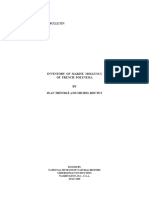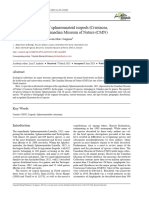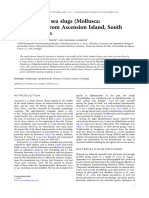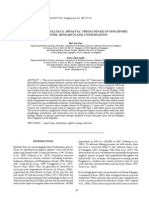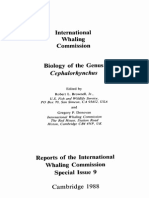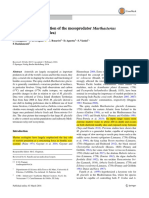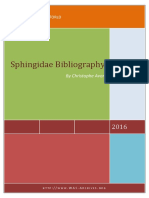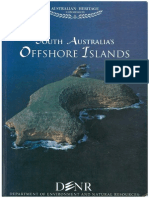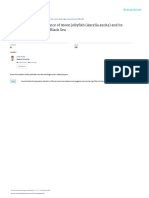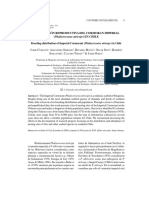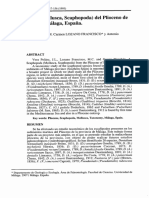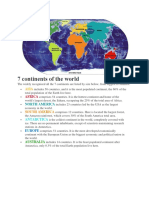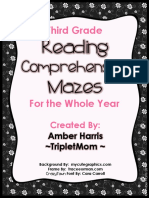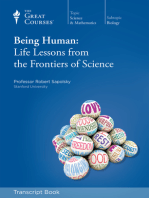Professional Documents
Culture Documents
Munilla Tomas & Soler Anna 2008
Uploaded by
Enndy Jose Gonzalez ParejoOriginal Description:
Copyright
Available Formats
Share this document
Did you find this document useful?
Is this content inappropriate?
Report this DocumentCopyright:
Available Formats
Munilla Tomas & Soler Anna 2008
Uploaded by
Enndy Jose Gonzalez ParejoCopyright:
Available Formats
Antarctic Science page 1 of 13 (2008) & Antarctic Science Ltd 2008
doi:10.1017/S095410200800151X
Check-list of the pycnogonids from Antarctic and sub-Antarctic waters: zoogeographic implications
S MUNILLA and ANNA SOLER MEMBRIVES TOMA
a, Universidad Auto noma de Barcelona, 08193 Bellaterra, Barcelona, Spain Unidad de Zoolog tomas.munilla@uab.es
Abstract: This study contains the current list of the austral pycnogonids together with details of their depth range and distribution. To date 264 species have been recorded, accounting for 19.6% of the 1344 species recorded worldwide. One hundred and eight species are endemic to Antarctic waters, 62 to the subAntarctic, 63 are common in both regions, and 55 are circumpolar. The richest genus is Nymphon, with 67 species and the richest area is the Scotia Sea. Comparing species lists between the years 2000 and 2007 shows that increased expeditions with more sampling has increased the circumpolarity of species and decreased zonal endemicity. The benthic insular refuge hypothesis is proposed as an explanation for the southern distribution of the present pycnogonid fauna, with an origin in the Scotia Arc.
Received 2 May 2007, accepted 13 March 2008
Key words: benthic insular refuge hypothesis, biogeography, circumpolarity, endemicity Introduction Pycnogonids (Chelicerata, Arthropoda) from Antarctic and sub-Antarctic waters have been studied more extensively than those from any other ocean of a similar size. Exploration of this area began with the American expedition of Nathaniel Palmer whose naturalist, James Eights (1835), described and drew the rst Antarctic pycnogonid Decolopoda australis on a serolid and some fossils. Pycnogonids have been collected by many scientists but the main monographs are by Hoek (1881), Mo bius (1902), Hodgson (1907, 1927), Bouvier (1913), Calman (1915), Gordon (1932, 1938, 1944), Fry & Hedgpeth (1969), Pushkin (1993) and Child (1994a, 1994b, 1995a, 1995b, 1995c). The most detailed information about the historical background of several families is contained in the Child papers, whilst the Pushkin monograph shows the geographical distribution of many species. The two latest Antarctic species to be described are Ammothe bigibossa Munilla, 2005 and Ammothea victoriae Cano & Lo pezGonzalez, 2007 from the Antarctic Peninsula and the Ross Sea respectively. The aim of this paper is to provide a complete up-to-date list of austral pycnogonids and, using zoogeographical information consider hypotheses describing their geographical distribution. Material and methods This paper is an analysis of published data. The works mentioned above, as well as the Mu ller catalogue (1993) and many others (Hoek 1898, Hodgson 1902, 1904, 1908, 1914, 1915, Bouvier 1905, 1906, Loman 1923, Calman 1933, Stephensen 1947, Hedgpeth 1950, Fage 1952a, 1952b, Utinomi 1959, Stock 1965, Arnaud 1972a, 1972b, Pushkin 1974, 1975a, 1975b, 1976, 1977, 1982, 1984a, 1984b, 1990, Turpaeva 1974, 1990, 1998, 2000, Krapp 1980, Child 1987, 1 1998, Pushkin 1988, Munilla 1989, 1991, 2000, 2001b, 2002, 2005, Stiboy-Risch 1992, 1993, 1994, Bamber 1995, 2007, Bamber et al. 2001, Chimenz & Gravina 2001), were used to compile the species list. The main zoogeographical works about pycnogonids are those of Fry (1964), Fry & Hedgpeth (1969), Hedgpeth (1969a, 1969b, 1971) and Munilla 2001a. Other works (Clarke & Crame 1989, 1997, Barnes & De Grave 2000, Clarke & Johnston 2003, Arntz et al. 2005, 2006, Barnes 2005, 2006, Clarke et al. 2005, Moyano 2005, Thatje et al. 2005, Gili et al. 2006, Linse et al. 2006), contain particular zoogeographical reviews of some zoological groups or global and evolutionary reviews of benthos. A total of 98 papers were consulted.
Results and discussion Historical research and specic richness This analysis of the austral pycnogonids covers 172 years, 16 countries and more than 42 ships or expeditions. So far 40 000 specimens have been found in the Antarctic and sub-Antarctic waters, (termed the Austral Ocean by Jacques & Treguer 1986, p. 133) at about 2100 sampled stations. The Southern Ocean usually contains the Antarctic waters south of the Polar Front and does not include sub-Antarctic localities between this front and the Subtropical Convergence (D. Barnes, personal communication 2007). This sub-Antarctic zone contains many islands with pycnogonids (see legend, Table I) and the South American zone (Magellan and Falkland zones). Bouvet Island is just south of the Polar Front, but given its isolation and that it acts as a link between sub-Antarctic and Antarctic fauna (Arntz et al. 2006), I consider it as another sub-Antarctic island. Moreover, the general composition of the actual
S MUNILLA & ANNA SOLER MEMBRIVES TOMA
Table I. Genera and species recorded in Antarctic (A) and sub-Antarctic (S) waters with regard to their depth and various geographical zones. W.sp number of world species. Antarctic waters: C circumpolar, Sc Scotia Sea, p Antarctic Peninsula, a Amundsen Sea, b Bellingshausen Sea, r Ross Sea, w Weddell Sea, e East Antarctic zone. sub-Antarctic waters: s South America, k Iles Kerguelen, c Ile Crozet, n New Zealand Plateau, t Tristan da Cunha, b Bouvet Is., M PE Marion & Prince Edwards Is., St.P A Saint Paul & Amsterdam Is. Genera/species Achelia A. assimilis (Haswell, 1875) A. communis (Bouvier, 1906) A. dorhni (Thompson, 1884) A. hoekii (Pfeffer, 1889) A. lagena Child, 1994a A. megacephala (Hodgson, 1915) A. parvula (Loman, 1923) A. quadridentata (Hodgson, 1910) A. serratipalpis (Bouvier, 1911) A. spicata (Hodgson, 1915) A. sufata Gordon, 1944 A. transfuga Stock, 1954 Ammothea A. adunca Child, 1994a A. allopodes Fry & Hedgpeth, 1969 A. antipodensis Clark, 1972 A. armentis Child, 1994a A. bentartica Munilla, 2001 A. bigibbosa Munilla, 2005 A. calmani Gordon, 1932 A. carolinensis Leach, 1814 A. clausi Pfeffer, 1889 A. cooki Child, 1987 A. dubia (Hedgpeth, 1950) A. gibbosa Bouvier, 1913 A. gigantea Gordon, 1932 A. glacialis (Hodgson, 1907) A. gordonae Child, 1994a) A. hesperidensis Munilla, 2000 A. longispina Gordon, 1932 A. meridionalis (Hodgson, 1915) A. minor (Hodgson, 1907) A. sextarticulata Munilla, 1989 A. spinosa Hodgson, 1907 A. striata Mo bius, 1902 A. stylirostris Gordon, 1932 A. tetrapora Gordon, 1932 A. tibialis Munilla, 2002 A. victoriae Cano & Lo pez, 2007 Ascorhynchus A. antipodus Child, 1987 A. cooki Child, 1987 A. cuculus Fry & Hedgpeth, 1969 A. hedgpheti Turpaeva, 1974 A. inatum Stock, 1963 A. ornatum (Helfer, 1938) 75 6 (8.0) 5340 14632992 9934008 37003910 27436070 90108 n n Sc Sc Sc k also in Argentine Basin W. sp. 80 A S sp. & % of W.sp 12 (15.4) 0 903 0 714 0 192 5 256 23137 shallow water 0 267 0 21 64361 0 1138 0 300 2 10 40 25 (62.5) 185800 2102000 0 24 230380 167335 517 991408 3 670 3 860 14632992 106 439567 991116 0 640 348732 30439 571454 10454 8 473 5 516 761679 72567 165494 105303 710 360366 w C k b n k Sc p Sc,p,b,r,w C C r b C C Sc,r Sc C C C C Sc,p,w,r C Sc,w,p Sc Sc r Livingston. Island, mud C Sc,p,b s,n s,t n s s k s St.Pl A also west Pacic and Australia A. brucei Calman, 1915 Depth (m) Antarctic zone sub-Antarctic zone Remarks and synonyms
also in Peru-Ecuador-Argentina
Sc,p,b,e. C w,e n
also on Angola coast described as Austrothea e: 40100E muddy bottom Magnammothea and Biammothea A. bicorniculata Stiboy-Risch, 1992
b s n described as Boehmia recorded as Colossendeis gibbosa Mo bius, 1902 145E178W. Magnammothea gigantea Fry & Hedgpeth, 1969
Livingston. Island, mud s
s b s s
also on South Georgia, Biammothea brevipalpa Puskin, 1993 also in Argentine Basin
also in PeruChile trench, South Africa, Kurile trench also in South Africa Continued
CHECK-LIST OF ANTARCTIC AND SUB-ANTARCTIC PYCNOGONIDS
Table I. (Continued) Genera and species recorded in Antarctic (A) and sub-Antarctic (S) waters with regard to their depth and various geographical zones. W.sp number of world species. Antarctic waters: C circumpolar, Sc Scotia Sea, p Antarctic Peninsula, a Amundsen Sea, b Bellingshausen Sea, r Ross Sea, w Weddell Sea, e East Antarctic zone. sub-Antarctic waters: s South America, k Iles Kerguelen, c Ile Crozet, n New Zealand Plateau, t Tristan da Cunha, b Bouvet Is., M PE Marion & Prince Edwards Is., St.P A Saint Paul & Amsterdam Is. Genera/species Austroraptus A. calcaratus Gordon, 1944 A. juvenilis Calman, 1915 A. polaris Hodgson, 1907 A. praecox Calman, 1915 A. sicarius Fry & Hedgpeth, 1969 Cilunculus C. acanthus Fry & Hedgpeth, 1969 C. cactoides Fry & Hedgpeth, 1969 C. kravcovi Pushkin, 1973 C. spinicristus Child, 1987 Dromedopycnon D. acanthus Child, 1982 Eurycyde E. antarctica Child, 1987 Sericosura S. mitrata (Gordon, 1944) Tanystylum T. antipodum Clark, 1977 T. brevicaudatum (Fage & Stock, 1966) T. brevipes (Hoek, 1881) T. bueroisi Arnaud, 1974 T. cavidorsum Stock, 1957 T. pfefferi Loman, 1923 T. neorhetum Marcus, 1940 T. oedinotum Loman, 1923 T. ornatum Flynn, 1928 T. styligerum Myers, 1875 Austrodecus A. breviceps Gordon, 1938 A. calcaricauda Stock, 1957 A. cestum Child, 1994b A. crenatum Child, 1994b A. curtipes Stock, 1957 A. elegans Stock, 1957 A. fagei Stock, 1957 A. fryi Child, 1994b A. glabrum Stock, 1957 A. glaciale Hodgson, 1907 A. goughense Stock, 1957 A. kelpi Pushkin, 1977 A. longispinum Stock, 1957 A. macrum Child, 1994b A. profundum Stock, 1957 A. pushkini Child, 1994b A. serratum Child, 1994b A. simulans Stock, 1957 A. sinuatum Stock, 1957 A. tristanense Stock, 1955 A. varum Child, 1994b Pantopipetta W. sp. 5 A S sp. & % of W.sp 5 (100) 143 219 3 500 10569 6 260 220 380 31 4 (12.9) 24402818 38540 255 309 476 540 2 21 6 45 1 (50) 124 903 1 (4.8) 527 714 1 (16.7) 106 2154 10 (22.2) shallow water 0 15 45100 80100 0 245 2 100 0 410 0 183 46560 0 200 42 22 (52.4) 0 298 731373 86207 1 360 0 903 99606 263400 112 859 18277 0 2100 42120 shallow water 91325 14422350 920 60903 79124 91545 shallow water 0 70 443 549 20 4 (20.0) Continued Sc Sc,p Sc,p Sc,w C n Sc C St.P A Sc k r p s n k n M PE,t n mud & stones, Graham Land southern Argentina Macquarie Island also in Gough Island among kelps k,n s n s,k M PE n St.P A p,St A St.P A. s,M PE,c,n s,k,n,t s,k M P.E s,k,n also in Cape Verde Island also in South Africa also in southern Chile T. dohrni Schimkewitsch, 1889 r also in Walvis Ridge (South Africa) r s also in Brazilian slope b Sc,p,e n c,M PE n also in Argentine Basin r,e C Sc,p,b,r,e C Sc,r e: 65E e: 92E, 145E e: 78E. Possibly C Depth (m) Antarctic zone sub-Antarctic zone Remarks and synonyms
Sc Sc Sc
b,w
Macquarie Island
S MUNILLA & ANNA SOLER MEMBRIVES TOMA
Table I. (Continued) Genera and species recorded in Antarctic (A) and sub-Antarctic (S) waters with regard to their depth and various geographical zones. W.sp number of world species. Antarctic waters: C circumpolar, Sc Scotia Sea, p Antarctic Peninsula, a Amundsen Sea, b Bellingshausen Sea, r Ross Sea, w Weddell Sea, e East Antarctic zone. sub-Antarctic waters: s South America, k Iles Kerguelen, c Ile Crozet, n New Zealand Plateau, t Tristan da Cunha, b Bouvet Is., M PE Marion & Prince Edwards Is., St.P A Saint Paul & Amsterdam Is. Genera/species P. P. P. P. australis (Hodgdon 1914) buccina Child 1994b lata Stock 1981 longituberculata Turpaeva, 1985 11 10 (90.9) 85920 3 280 1632955 3 1180 1042100 45645 12001280 50580 5801180 45550 35 7 6 1 (2.9) 73578 1 (14.3) 5813777 3 (50) 3 415 1122612 1586 16 2 (12.5) 250 320 6 86 1 (16.7) 3 30 18 (20.9) 35383 104830 0 430 65600 1461530 115260 22732421 117430 15275 12283060 1001138 0 400 3 4540 Sc Sc,w,p,e Sc Sc w Sc,p r Sc Sc,w,e Sc Sc,p,r,w C s also in waters of Uruguay, Brazil and Argentine e: 69S 14E also in Surinam & W. Atlantic k Sc c k,n n n P,w p s also at 23S (off Brazil) C Sc,e C C C C Sc C e Sc,r A. spicata Hodgson, 1915 Pseudopallene brachyura Bouvier, 1911 holotype without gures b,c W. sp. A S sp. & % of W.sp Depth (m) 6805340 31933423 5233655 5676700 Antarctic zone Sc,r Sc b,w Sc sub-Antarctic zone M PE,n also in Concepcio n waters, Chile also in Cape Basin, South Africa also in SW Africa, Pacic & all Atlantic P. brevicauda Stock, 1963 Austropallene A. brachyura Bouvier, 1913 A. A. A. A. A. A. A. A. A. bucera Pushkin, 1993 calmani Gordon, 1944 cornigera (Mo bius, 1902) cristata Bouvier, 1911 gracilipes Gordon, 1944 spinicornis Pushkin, 1993 tcherniai Fage, 1952 tenuicornis Pushkin, 1993 tibicina Calman, 1915 Remarks and synonyms
holotype without gures holotype without gures n
Callipallene C. margarita Gordon, 1932 Cheilopallene Ch. gigantea Child, 1987 Oropallene O. dimorpha (Hoek, 1898) O. dolichodera Child, 1995c O. metacaula Child, 1995c Pseudopallene P. centrotus Pushkin, 1990 P. glutus Pushkin, 1975 Seguapallene S. insignatus Pushkin, 1975 Pallenopsis P. boehmi Schimkewitsch, 1930 P. P. P. P. P. P. P. P. P. P. P. P. buphthalmus Pushkin, 1993 candidoi Mello-Leitao, 1949 gurjanovi Pushkin, 1993 kupei Clark, 1971 latefrontalis Pushkin, 1993 lateralia Child, 1995c lattina Pushkin, 1993 leiopus Pushkin, 1993 longiseta Turpaeva, 1958 macronix Bouvier, 1911 oblicua Thompson, 1884 patagonica (Hoek, 1881)
Holoptype with gures n n s also Subarctic & Gulf of Panama P. knipovitchi Turpaeva, 1974 rock & algal bottoms described as Phoxichilidium patagonicum P. hiemalis Hodgson, 1907 P. glabra Mo bius, 1902 P. mo biusi Pushkin, 1975 P. meridionalis Pushkin, 1975 P. hodgsoni Gordon, 1938 Cheilopallene spicata Stock, 1955, Clavigeropallene spicata Pushkin, 1974 also in Uruguay, Brazil, Argentina P. gau ssiana Hodgson, 1914 Continued
P. pilosa (Hoek, 1881) P. spicata Hodgson, 1914 P. tumidula Loman, 1923 P. vanho ffeni Hodgson, 1915
253650 25549 42270 3 889
C C Sc C
CHECK-LIST OF ANTARCTIC AND SUB-ANTARCTIC PYCNOGONIDS
Table I. (Continued) Genera and species recorded in Antarctic (A) and sub-Antarctic (S) waters with regard to their depth and various geographical zones. W.sp number of world species. Antarctic waters: C circumpolar, Sc Scotia Sea, p Antarctic Peninsula, a Amundsen Sea, b Bellingshausen Sea, r Ross Sea, w Weddell Sea, e East Antarctic zone. sub-Antarctic waters: s South America, k Iles Kerguelen, c Ile Crozet, n New Zealand Plateau, t Tristan da Cunha, b Bouvet Is., M PE Marion & Prince Edwards Is., St.P A Saint Paul & Amsterdam Is. Genera/species W. sp. A S sp. & % of W.sp Depth (m) Antarctic zone sub-Antarctic zone Remarks and synonyms P. setigera Hodgson, 1914 P. villosa Hodgson, 1907 Colossendeis C. adelpha Child, 1998 C. angusta Sars, 1877 C. arundorostris (Fry & Hedpeth, 1969) C. australis Hodgson, 1907 C. avidus Pushkin, 1970 C. belekurovi Pushkin, 1993 C. brevirostris Child, 1995b C. colossea Wilson, 1881 C. concedis Child, 1995b C. drakei Calman, 1915 C. elephantis Child, 1995b C. enigmatica Turpaeva, 1974 C. ensifer Child, 1995b C. fragilis Pushkin, 1992 C. grassus Pushkin, 1993 C. hoecki Gordon, 1944 C. insolitus Pushkin, 1993 C. korotkevischi Pushkin, 1984 C. kurtchatovi Turpaeva, 1993 C. leniensis Pushkin, 1993 C. lepthorynchus Hoek, 1881 C. longirostris Gordon, 1932 C. macerrima Wilson, 1881 C. media Hoek, 1881 C. megalonix Hoek, 1881 75 36(48.0) 333 341 225480 610 153935 270 426 150 377 5449604 425 4140 22482907 3 3000 23844795 315 335 32503285 3 830 315 435 120 3112 132 660 4700 250 432 561 3675 2 3700 20102100 33865798 7 4900 e Sc r C p,w,e a Sc,w Sc,r C Sc,e Sc Sc Sc,e Sc Sc,w,r w k c cosmopolitan s also in southern Tasmania C. smirnovi Pushkin, 1988 also in Chile & Argentina C. acuta Stiboy-Rich, 1993 Prydz Bay cosmopolitan C. gracilis Hoek, 1881 160 2804 C
s k,n s k,c s 52S 43E M PE,s n n
47S, Argentina
Sc C s,k,n
C. mica Pushkin, 1970 C. notialis Child, 1995b C. pseudochelata Pushkin, 1993 C. robusta Hoek, 1881 C. glacialis Hodgson, 1907 C. scoresbii Calman, 1915 C. scotti Calman, 1915 C. stramendi Fry & Hedgpeth, 1969 C. tenuipedis Pushkin, 1993 C. tethya Turpaeva, 1974 C. tortipalpis Gordon, 1932 C. wilsoni Calman, 1915 Decolopoda D. australis Eights, 1835 D. quasami Sree et al., 1993 2 2 (100)
1400 260 380 125 180 0 3610
378S 228E k Sc,e C b,k
south of Iles Crozet cosmopolitan C. pennata Pushkin, 1970 also in southern Tasmania cosmopolitan. C. japonica, Hoek, 1898, C. spei also in Argentina C. brevipes Hoek, 1881 also in South Africa, Madagascar & E. Argentina C. rugosa Hodgson, 1907 C. frigida Hodgson, 1907 C. orcadense Stock, 1963 Sub-Antarctic Indian Ocean e: 69S, 11E C. lilliei Calman, 1915 C. gracillipes Bouvier, 1911 C. rostrata Turpaeva, 1994
130 5227 35352 645 3806 250 860 318 160 4026 60801 0 1890 150
Sc,w,r C
s s
C Sc,w C Sc,w,r Sc,p,b,w,r e
s s,k
also in E. Argentina
also in Ade lie Land k possibly C D. antarctica Bouvier, 1905
Continued
S MUNILLA & ANNA SOLER MEMBRIVES TOMA
Table I. (Continued) Genera and species recorded in Antarctic (A) and sub-Antarctic (S) waters with regard to their depth and various geographical zones. W.sp number of world species. Antarctic waters: C circumpolar, Sc Scotia Sea, p Antarctic Peninsula, a Amundsen Sea, b Bellingshausen Sea, r Ross Sea, w Weddell Sea, e East Antarctic zone. sub-Antarctic waters: s South America, k Iles Kerguelen, c Ile Crozet, n New Zealand Plateau, t Tristan da Cunha, b Bouvet Is., M PE Marion & Prince Edwards Is., St.P A Saint Paul & Amsterdam Is. Genera/species Dodecolopoda D. mawsoni Calman & Gordon, 1933 Heteronymphon H. exiguum (Hodgson, 1927) Nymphon N. adareanum Hodgson, 1907 N. andriashevi Puskin, 1993 N. arcuatum Child, 1995a N. articulare Hodgson, 1908 N. australe Hodgson, 1902 N. stylops Bouvier, 1913 N. biarticulatum Hodgson, 1907 N. bouvieri Gordon, 1932 N. brachyrhynchum Hoek, 1881 N. brevicaudatum Miers, 1875 N. bucuspidum Child, 1995a N. chaetodir Utinomi, 1971 N. charcoti Bouvier, 1911 N. clarencei Gordon, 1932 N. compactum Hoek, 1881 N. eltaninae Child, 1995a N. forticulum Child, 1995a N. frigidum Hodgson, 1907 N. galatheae Fage, 1956 N. gerlachei Giltay, 1937 N. glabrum Child, 1995a N. gracilipes Miers, 1875 N. gruzovi Pushkin, 1993 N. hadale Child, 1982 N. hamatum Hoek, 1881 N. hiemale Hodgson, 1907 N. inferum Child, 1995a N. inornatum Child, 1995a N. isabellae Turpaeva, 2000 N. isaenki Pushkin, 1993 N. lanare Hodgson, 1907 N. lomani Gordon, 1944 N. longicolum Hoek, 1881 N. longicoxa Hoek, 1881 N. longisetosum Hodgson, 1915 N. macquarensis Child, 1995a N. macrochelatum Pushkin, 1993 N. mendosum (Hodgson, 1907) N. microgracilipes Pushkin, 1993 N. monotrix Child, 1995a N. multidens Gordon, 1944 N. multituberculatum Gordon, 1944 N. neelovi Pushkin, 1993 N. neumayeri Gordon, 1932 N. orcadense (Hodgson, 1908) W. sp. 1 A S sp. & % of W.sp 1 (100) 160549 7 268 1 (14.3) 3 415 67 (25.0) 1 903 116135 38157 18910 8 4136 Sc,p,r,e p Sc,p,w C s s s s,n,b C n described as Nymphon Chaetonymphon also in SE Argentina, possibly C C Depth (m) Antarctic zone sub-Antarctic zone Remarks and synonyms
also Indian Ocean & off ArgentineChilean coasts
35889 158583 82430 271100 1262 9951110 3 1200 65342 7313246 4671233 438548 227 31115798 460578 55 3 3055 250 30105798 25023400 301435 24503873 513 333571 500700 60848 112714 684600 3182998 3852450 112124 540 15555 150309 34953514 40260 180640 65240 160403 18163
C Sc,p,e C
k k k n n also in Heard Island
C Sc Sc Sc,r r w p,b Sc w,e p,w Sc Sc C Sc, Palmer Is. w w C C C Sc,b,r e 68S 32E,w C B r Sc,p,b w,Sc,e Sc Sc,p Sc,p
n s
also in South Africa s: SE Argentine
also in Kermadec Trench, (SW Pacic Ocean) holotype is a juvenile also in Argentine basin N. gracillimum Calman, 1915
k n n n n
also in Chilean Basin & New Zealand also in Argentine Basin
c: 46S 49E
b e: 20140E c s s Continued
CHECK-LIST OF ANTARCTIC AND SUB-ANTARCTIC PYCNOGONIDS
Table I. (Continued) Genera and species recorded in Antarctic (A) and sub-Antarctic (S) waters with regard to their depth and various geographical zones. W.sp number of world species. Antarctic waters: C circumpolar, Sc Scotia Sea, p Antarctic Peninsula, a Amundsen Sea, b Bellingshausen Sea, r Ross Sea, w Weddell Sea, e East Antarctic zone. sub-Antarctic waters: s South America, k Iles Kerguelen, c Ile Crozet, n New Zealand Plateau, t Tristan da Cunha, b Bouvet Is., M PE Marion & Prince Edwards Is., St.P A Saint Paul & Amsterdam Is. Genera/species N. pagophylum Child, 1995a N. paucidens Gordon, 1932 N. paucituberculatum Gordon, 1944 N. pfefferi Loman, 1923 N. phasmatoides Bo hm, 1879 N. polare Hodgson, 1915 N. premordicum Child, 1995a N. proceroides Bouvier, 1913 N. procerum Hoek, 1881 N. proximum Calman, 1915 N. pseudogracilipes Pushkin, 1993 N. punctum Child, 1995a N. rybakovi Pushkin, 1993 N. sabellum Child, 1995 N. scotiae Stock, 1981 N. subtile Loman, 1923 N. tenuimanum Hodgson, 1914 N. tenuipes Bouvier, 1911 N. trituberculum Child, 1995a N. typhops (Hodgson, 1915) N. unguiculatum Hodgson, 1927 N. villosum (Hodgson, 1915) N. zundiamum Pushkin, 1993 Pentanymphon P. antarcticum Hodgson, 1904 Sexanymphon S. mirabilis Hedgpeth & Fry, 1964 Anoplodactylus A. australis (Hodgson, 1914) A. californicus Hall, 1912 A. laciniosus Child, 1995c A. laminifer Arnaud, 1974 A. petiolatus (Kro yer, 1844) A. speculus Child, 1995c A. typhlops Sars, 1888 1 1 1 (100) 3 3227 1 (100) 16872897 140 9 (6.4) 15616 0 100 456 540 80100 0 1180 15861640 915 3620 C t s n St.P A s n c,n,PE also in Tasmania cosmopolitan; C. projectus Hilton, 1942, C. portus Sawaya 1950 also in Antipodes Island also in Atlantic Mediterranean cosmopolitan A. pelagicus Flynn, 1908 A. neglectus Hoek, 1898 also in Atlantic Mediterranean Sc,p C P. minutum Gordon, 1944 W. sp. A S sp. & % of W.sp Depth (m) 265 1170 22334 180 219 12250 1394 350 25973215 911180 24506135 401555 195 216 415 220 28722928 29602980 13304 19033398 122 1180 32003259 24502815 168 450 13636 160 Antarctic zone Sc,p,w Sc w,e Sc p,w e Sc Sc,p,e Sc C k n Sc,w r Sc s,k r C e Sc,p,w,e Sc C s 62S160W N. stocki Turpaeva, 1974 also SE Argentine also in S. Australia N. soyae Utinomi, 1953 sub-Antarctic zone c Remarks and synonyms
also SE Argentina
s also in South Africa; P. capense Hodgson, 1908
cosmopolitan N. banzare Gordon, 1944
also 10E s: near Falkland Islands
Sc
A. vemae Child, 1982 A. virescens (Hodge, 1864) Phoxichilidium P. pigordum Child, 1995c Endeis E. australis (Hodgson, 1907) E. viridis Pushkin, 1976 Pentapycnon P. bouvieri Puskin, 1993 P. charcoti Bouvier, 1910 Pycnogonum 69 10 (14.5) 14 17 1 (7.1)
90676 0 16 79124 2 (11.8) 3 1570 3 377 3 2 (66) 90419 240 1420 Sc,w Sc,p,r C
s St.P A n n,b k,c,M PE
P. bouvieri Child (1993) P. magnum Stiboy-Rish (1994)
Continued
S MUNILLA & ANNA SOLER MEMBRIVES TOMA
Table I. (Continued) Genera and species recorded in Antarctic (A) and sub-Antarctic (S) waters with regard to their depth and various geographical zones. W.sp number of world species. Antarctic waters: C circumpolar, Sc Scotia Sea, p Antarctic Peninsula, a Amundsen Sea, b Bellingshausen Sea, r Ross Sea, w Weddell Sea, e East Antarctic zone. sub-Antarctic waters: s South America, k Iles Kerguelen, c Ile Crozet, n New Zealand Plateau, t Tristan da Cunha, b Bouvet Is., M PE Marion & Prince Edwards Is., St.P A Saint Paul & Amsterdam Is. Genera/species P. P. P. P. P. P. P. P. P. calculum Bamber, 1955 rhinoceros Loman, 1923 gaini Bouvier, 1910 gordonae Pushkin, 1984 magellanicum Hoek, 1898 magniroste Mo bius, 1902 paragaini Munilla, 1989 platylophum Loman, 1923 sivertseni Stock, 1955 19 4 (21.1) 60900 100140 0 101 0 77 C s,k,n k S,n s described as Austrodecus also in Mexico also in Caribbean Sea, E. Pacic Ocean, Azores, Mediterranean Sea W. sp. A S sp. & % of W.sp Depth (m) littoral 301115 242495 219400 85548 3 309 205440 0 903 102141 Antarctic zone Sc C C w,e sub-Antarctic zone s k s k,c Sc Sc,e k,c t Remarks and synonyms rock with algae P. diceros Marcus, 1940
Rhynchothorax R. australis Hodgson, 1907 R. oblongus (Pushkin, 1977) R. percivali Clark, 1976 R. philopsammum Hedgpeth, 1951 Total species
264
192
137
Bouvet fauna is more similar to the Magellan area than the high Antarctic region (Arntz et al. 2006). These individuals belong to 31 genera and 264 different species of pycnogonids (Table I), out of a total number of species worldwide of 1344. They thus represent 19.6% of the actual world species that have been recorded in 21% of the ocean areas (Jacques & Treguer 1986). Figure 1 shows the richness of species and genera for each family. Nymphonidae is the most abundant family (71 species), with Nymphon the major genus (67 species), and N. australe the most frequently recorded species. Of these 264 species, 108 are endemic in the Antarctic area, 62 are present only in the sub-Antarctic zone and 63 are common to both. Table I shows the current list of the Antarctic and sub-Antarctic species, their synonyms (47), the percentage
of species per genus with respect to their number worldwide, their geographical distribution and bathymetric range. The majority of synonyms have been proposed or recorded in the Child (1994a, 1994b, 1995a, 1995b, 1995c), Pushkin (1993) and Mu ller (1993) papers. The richest zone, with 89 recorded non-circumpolar species, is the Scotia Sea, followed by the sub-Antarctic islands with 64 species. The circumpolarity criterion is that a species
Table II. Variation in the austral pycnogonid species between 2000 and 2007. Differences between seven years Species in the world Species in the Southern Ocean (sensu lato) Species reported in Antarctic waters Species reported in sub-Antarctic waters Endemic species in Antarctic waters Endemic species in sub-Antarctic waters Common species Circumpolar species Circumpolar genera Cosmopolitan species Endemicity of species from Antarctic zones Scotia Sea Antarctic Peninsula Bellingshausen Sea Amundsen Sea Ross Sea Weddell Sea East Antarctica Total Endemicity of species from sub-Antarctic zones South America (Magellan region) New Zealand Plateau sub-Antarctic Islands Bouvet Island 2000 1165 251 180 131 101 59 60 45 13 5 2000 26 4 1 1 8 4 8 52 10 21 24 2007 1344 264 192 138 108 62 63 55 15 7 2007 22 3 0 1 9 3 4 42 10 23 24
Fig. 1. Richness of species and genera from austral pycnogonid families.
CHECK-LIST OF ANTARCTIC AND SUB-ANTARCTIC PYCNOGONIDS
was recorded on one or more occasions in each of the waters to the north, south, east and west of the Antarctic continent, with the east zone the largest one and least sampled (it contains 24 species of which only four are endemic).
Zoogeography The Antarctic benthos has evolved as a consequence both of the abiotic environmental conditions in the past and of biotic interactions (Arntz et al. 1994). The distribution of most of the benthic Antarctic fauna is considered as circumpolar (Hedgpeth 1971, Arntz & Gallardo 1994, Clarke & Crame 1997), almost certainly due to the powerful Antarctic Circumpolar Current (Clarke & Johnston 2003). The circumantarctic element is also the most frequent pattern for pycnogonids (Fry & Hegdpeth 1969, Hegdpeth 1969a, Munilla 2001a), since at present 55 of the 192 (28.7%) Antarctic recorded species are circumpolar. The comparative data in Table II, based on cruise data and literature dealing with austral pycnogonids over a period of seven years, shows that the number of endemic species for each Antarctic zone is low, with the exception of the Scotia Sea, which could be considered as a sub-centre of speciation. Moreover, this table shows that the circumantarctic pattern for the pycnogonid species has increased over the seven years, and the endemicity of the species from each zone has consequently decreased. In other words, increased sampling has shown more circumpolarity and less zonal endemicity. Only 10 genera are exclusively from austral waters and four of them (Dodecolopoda, Pentanymphon, Sexanymphon, Austroraptus) are endemic to Antarctic waters. Other genera (Decolopoda, Austropallene) which were considered by Hegdpeth (1969b) as typically Antarctic, have already been found in sub-Antarctic waters, including in the Kuril Islands (Austropallene likinii Turpaeva, 2002); the same is true for some species. The genera with the most species in austral
waters are: Ammothea (25 species out of 40 in the world; 62.5%), Colossendeis (36 out of 75; 48%), Austrodecus (22 out of 42; 52.4%), Nymphon (67 out of 268; 25.0%) and Pallenopsis (18 out of 86; 20.9%). There are not endemic families. The sub-Antarctic pycnogonid fauna shows origins in the Antarctic fauna at genus level (Arnaud & Bamber 1987). For example, this is true of Colossendeis and Ammothea, two genera with more than half of their species in the Austral Ocean. Like other genera with abundant species, both have more species in Antarctic than in sub-Antarctic waters. We therefore view the Southern Ocean as a centre of speciation (suggested by Hedgpeth 1969b, and Munilla 2001a) but also of geographic dispersion and evolutive radiation, because of its high relative endemicity (108 Antarctic species versus 62 of sub-Antarctic ones). The dendrogram (Fig. 2), based on the presence-absence data of the 264 austral species, shows that the Antarctic species form a large zoogeographic group linked to circumpolarity (55 species). Three trends are clear: a) The Scotia Sea is closely linked to other southern zones (60.75% of similarity), indicating some peculiarity of the former. b) Two branches of the Circumpolar Current (with 71% of similarity) have been differentiated: the north-eastern (Antarctic Peninsula Weddell-East zones) and the southern (Bellingshausen Ross zones). This supports the geographical proximity of the species distribution to the direction of the Circumpolar Current. c) Each sub-Antarctic zone is separate, and the three zones (Magellan region, New Zealand and sub-Antarctic islands), present low levels of similarity ( , 30%, Fig. 2) to Antarctic waters. The suites of organisms in the seas surrounding the sub-Antarctic islands, have long been considered sufciently dissimilar to
Fig. 2. Similarity of Antarctic and subAntarctic zones (Bray-Curtis Index, complete linkage), based in presenceabsence data. CircumAntarctic species are included. n New Zealand Plateau, s South America, s.Is subAntarctic islands, Sc Scotia Sea, R Ross Sea, B Bellingshausen Sea, Pn Antarctic Peninsula, W Weddell Sea, E East zone.
10
S MUNILLA & ANNA SOLER MEMBRIVES TOMA
constitute a different zone (Hedgepth 1969a), with 63 species at present. Recent multivariate analysis of the bryozoan component of benthos south of 47S supports the categorization of Patagonia, the subAntarctic islands and Antarctica into separate zones (Barnes & De Grave 2000). Two complementary hypotheses (Clarke & Johnston 2003) may explain the possible origin of todays Antarctic benthic fauna: 1. It comes from an in situ stock in Cretaceous waters (141 65 Ma), from the coastal fauna of Gondwana, when the present Antarctic continent was part of the supercontinent. This is supported by the Gasteropoda (Clarke 1990), two Isopoda families (Brandt 1992) and some sessile groups (Alcyonarians and sponges, Gili et al. 2006) among others. 2. There was subsequent interchange with the deep fauna of the contiguous oceans, as is the case with Tanaidacea and Amphypoda (Brandt 1999). One possibility is that the Magellan region provided Antarctic benthic fauna across the Drake Passage or the Scotia Arc. This may be the case in some groups such as Serolidae (Held 2000), Polychaeta (Montiel et al. 2004) and Bryozoa (Moyano 2005, Barnes 2006). The Scotia Arc and Bouvet Island are clearly undersampled, if they are considered as transitory areas between the Magellan region and the Antarctic Peninsula or the Weddell Sea (Arntz et al. 2005). Modern Antarctic communities are thus composed of a mixture of Palaeozoic taxa, which migrated from the deep ocean during interglacial periods, and a component of fauna that evolved from common Gondwana Cretaceous ancestors (Gili et al. 2006). The nal connection between South America and the Antarctica was broken just over 25 Ma ago. The result was the formation of the Circumpolar Current, causing the oceanographic and geographical isolation of the Antarctic continent. The continental remains of the ancient isthmus today form many of the islands adjacent to the Antarctic
Table IV. Number of species recorded in each zone (in bold) and common species between different zones. Circumpolar species are excluded. S s Sc Pn R W B E n s.Is 46 14 10 3 5 1 1 8 10 Sc 14 89 24 18 20 8 16 11 12 Pn 10 24 35 7 14 5 8 2 3 R 3 18 7 27 8 3 4 4 3 W 5 20 14 8 35 4 11 2 7 B 1 8 5 3 4 12 2 1 3 E 1 16 8 4 11 2 24 0 2 n 8 11 2 4 2 1 0 47 11 s.Is. 10 12 3 3 7 3 2 11 64 Tot 52 123 73 50 71 27 44 39 49
s South America, Sc Scotia Sea, Pn Antarctic Peninsula, R Ross Sea, W Weddell Sea, B Bellingshausen Sea, E East zone, n New Zealand Plateau, s.Is sub-Antarctic islands. Tot sum of the common species for each zone and the remaining ones.
Peninsula, but the main topographical obstacle between South America and Antarctica is the Scotia Arc, through which the Circumpolar Current passes. Two main probable dispersion routes of pycnogonids are proposed, coming from the ancient Cretaceous fauna and principally along the bottom (since they have benthic larvae): 1. From Western Antarctica to the Eastern zone by means of the Circumpolar Current. In support of this, there are 15 common non-circumpolar species between the Scotia ArcAntarctic Peninsula couplet and the Eastern Antarctic zone. Moreover, a branch of the dendrogram (PnWE, Fig. 2) also supports this suggestion. 2. From South America to western Antarctica going along the route from the Scotia Arc. This is supported by 17 common non-circumpolar species between the Scotia Arc Antarctic Peninsula couplet and the Magellan zone; moreover, 13 of 48 austral species recorded in other waters have been also found in the Argentine and Brazilian zones (the Brazil current versus circumpolar one).
The benthic insular refuge hypothesis The submerged zones of the Peter I and Thurston islands in the Bellingshausen Sea are sheltered areas and optimal zones for the settlement and protection of pycnogonid fauna from the surrounding open seas, similar to oases in the desert. They are species rich and the densities of animals are here higher than on open bottoms (Table III), probably because of more feeding possibilities. Animals can be transported from them by deep currents, including by hitchhiking on a moving animal or debris or by simply drifting to other waters. This trend, observed in the Bellingshausen Sea, is extensive in other waters, and occurs in Bouvet Island, which act as stepping stones (Arntz et al. 2006) to Antarctic waters.
Table III. Specimens and species of pycnogonids from islands and the open Bellingshausen Sea, in the Bentart-03 Cruise. Zones Bentart-03 Stations (st.) Latitude S n S n/S mean S/st. mean n/st. mean Depth (m) Thurston Peter I islands 8 6870 187 13 14.4 1.6 23.4 86726 Bellingshausen Sea 9 6870 12 10 1.2 1.1 1.3 492 1947
n number of specimens, S number of species
CHECK-LIST OF ANTARCTIC AND SUB-ANTARCTIC PYCNOGONIDS
11
The benthic insular refuge hypothesis suggests that the islands serve as a home, accumulating a rich benthic fauna, and subsequently acting as migration points. This is similar to the reserve effect of a marine protected zone. This theory needs to be conrmed using more quantitative data about species richness, densities and biomass in pycnogonids and many other zoological groups. Far from any island, deep waters of under 1000 m, have few species and specimens (Munilla 2001a). Moreover, no circumpolar species have been recorded (Table IV) and the number of endemic species (Table II) in each austral zone is much more important at islands (Scotia Sea, New Zealand Plateau and sub-Antarctic ones) than at the benthic bottoms of the open seas. There also seems to be no decreasing latitudinal decline of species richness if the sub-Antarctic islands are included (Table II and IV), because there are more species in Antarctic waters than in sub-Antarctic ones.
large number of common species between the Scotia Sea Arc and remaining zones (123, Table IV) support this movement of pycnogonids. The low water temperature is the main factor that isolates the Antarctic species, leading to high endemism in various groups (108 of 192, 56.3% in pycnogonids). With the warming of global oceans, the colonization of the Antarctic waters will be greater in the future. The number of species will increase and the relative Antarctic endemicity will decrease. This trend will be favoured by the increasing passive transport of animals or algae on various ships, swimming animals and oating debris. Eddies and currents are factors that also contribute to passive transport (Barnes et al. 2006).
Acknowledgements This work was carried out under the auspices of two MEC grants (CGL 2004 01856/ANT, REN 2001-1074/ANT) of the Spanish Council of Scientic and Technical research. I would like to express my gratitude to the scientic colleagues of the Bentart cruises aboard the Hesperides oceanographic Spanish vessel. Likewise, we are grateful to the reviewers and the Editor for their constructive suggestions which improved the paper.
Possible stages in the origin and dispersion of the Antarctic pycnogonids 1. In situ origin (Munilla 2001a), from the Cretaceous Gondwana fauna (141 65 Ma). This possibility is supported by the two most ancient families of the sea spiders (Colossendeidae and Austrodecidae, (Arango & Wheeler 2007, Bamber 2007), morphological and molecular data, having 48% and 42% respectively of their species in southern waters. This hypothesis has been suggested previously for Austrodecidae genera (Stock 1957, Child 1995b). 2. Many archipelagos in the Scotia Arc are the tips of an almost continuous subsurface mountain chain linking the Andes and the Antarctic Peninsula (Barnes 2005). All the Scotia Sea islands sheltered the existing fauna at the time of its creation and they still retain the ancient Cretaceous fauna that the Antarctic Circumpolar Current (ACC) subsequently carries, because the Scotia Arc is the only major barrier to the circulation of this current. Many more species remain on its islands than in other waters, as shown by the large number of species that have been captured in this zone (Table IV): 89 non-circumpolar species plus 55 circumpolar ones, that is the 75% of the 192 recorded Antarctic species. 3. From the Scotia Arc waters, the fauna was, and today still is, actually exported towards the East Antarctic zone thanks to the Circumpolar Current, which also distributes some species to the sub-Antarctic islands. A similar trend happens with the benthic larvae of cheilostome bryozoa (Bouvet Island, Barnes 2006). Moreover, the Scotia Arc pycnogonid fauna also arrive at the southern branch of the Circumpolar Current (Bellinghausen Ross Sea, Fig 2). This link is shown in the cluster in Fig. 2, where the Scotia Sea branch is closely related to other Antarctic zones. The
References
ARANGO, C. & WHEELER, W.C. 2007. Phylogeny of the sea spiders (Arthropoda, Pycnogonida) based on direct optimization of six loci and morphology. Cladistics, 23, 255 293. ARNAUD, F. 1972a. 9 Pycnogonides. Inverte bre s marins. XIIeme et XVeme thys, 4, 135156. expeditions antarctiques franc aises en Terre Ade lie. Te ARNAUD, F. 1972b. Pycnogonides des les Kerguelen (Sud Oce an Indien); mate riel nouveau et re vision des spe cimens du Muse um National dHistoire Naturelle de Paris. Bulletin du Museum National dHistoire Naturelle, 3, 801 815. ARNAUD, F. & BAMBER, R.N. 1987. The biology of Pycnogonida. Advances in Marine Biology, 24, 1 96. ARNTZ, W. & GALLARDO, V.A. 1994. Antarctic benthos: present position and future prospects. In HEMPEL, C., ed. Antarctic science: global concerns. Berlin: Springer, 243 277. ARNTZ, W., BREY, T. & GALLARDO, V.A. 1994. Antarctic zoobenthos. Oceanographic Marine Biology Annual Review, 32, 241 304. ARNTZ, W., THATJE, S., GERDES, D., GILI, J.M., GUT, J., JACOB, U., MONTIEL, , N. 2005. The Antarctic Magellan connection: A., OREJAS, C. & TEIXIDO macrobenthos ecology on the self and upper slope, a progress report. Scientia Marina, 69, 237 269. ARNTZ, W., THATJE, S., LINSE, K., AVILA, C., BALLESTERROS, M., BARNES, D., COPE, T., CRISTOBO, F., DE BROYER, C., GUT, J., ISLA, E., LOPEZ GONZALEZ, , A., RAUPACH, M., RAUSCHERT, P., MONTIEL, A., MUNILLA, T., RAMOS ESPLA , N. 2006. Missing link in the Southern M., RODRIGUEZ, E. & TEIXIDO Ocean: sampling the marine benthic fauna of remote Bouvet Island. Polar Biology, 29, 83 96. BAMBER, R.N. 1995. A new species of Pycnogonum Bru nnich 1764 (Arthropoda, Pycnogonida) with other pycnogonid records from the Falkland and South Shetland Islands. Ophelia, 40, 199 205. BAMBER, R.N. 2007. A holistic re-interpretation of the phylogeny of the Pycnogonida Latreille, 1810. Zootaxa, 1668, 295 312.
12
S MUNILLA & ANNA SOLER MEMBRIVES TOMA
CLARKE, A., BARNES, D.K.A. & HODGSON, D.A. 2005. How isolated is Antarctica? Trends in Ecology and Evolution, 20, 13. EIGHTS, J. 1835. Description of a new animal belonging to the Arachnides of Latreille, discovered in the sea along the shores of the New South Shetland Islands. Boston Journal of Natural History, 1, 203 206. timent polaire Commandant FAGE, L. 1952a. Pycnogonides. Missions du ba Chargot, re coltes faites en Terre Ade lie (1950). Bulletin du Museum National dHistoire Naturelle, 2 (24) 2, 180186. lie. Bulletin du Museum FAGE, L. 1952b. Pycnogonides de la Terre Ade National dHistoire Naturelle, 2 (24) 3, 263273. FRY, W.G. 1964. The pycnogonid fauna of the Antarctic continental shelf. In CARRICK, R., HOLDGATE, M.W. & PROVOST, J., eds. Biologie Antarctique. Paris: Hermann, 263269. FRY, W.G. & HEDGPETH, J.W. 1969. Pycnogonida, 1. Colossendeidae, Pycnogonidae, Endeidae and Ammotheidae. Fauna of the Ross Sea, 7. Memoirs of the New Zealand Oceanographic Institute, 49, 1 149. GILI, J.M., ARNTZ, W., PALANQUES, A., OREJAS, C., CLARKE, A., DAYTON, P.K., , N., ROSSI, S. & LO PEZ-GONZA LEZ, P.J. 2006. A ISLA, E., TEIXIDO unique assemblage of epibenthic sessile suspension feeders with archaic features in the high-Antarctic. Deep Sea Research II, 53, 1029 1052. GORDON, I. 1932. Pycnogonida. Discovery Reports, 6, 1 138. GORDON, I. 1938. Pycnogonida. Scientic Reports of the Australasian Antarctic Expedition, Zoology & Botany, 2 (8), 1 40. GORDON, I. 1944. Pycnogonida. Reports of the British, Australian and New Zealand Expedition, B5 (1), 1 72. HEDGPETH, J.W. 1950. Pycnogonida of the United States Navy Expedition, 194748. Proceedings U.S. National Museum, 100, 147160. HEDGPETH, J.W. 1969a. Introduction to Antarctic zoogeography. Antarctic Map Folio Series, 11, 19. HEDGPETH, J.W. 1969b. Pycnogonida. Antarctic Map Folio Series, 11, 2628. HEDGPETH, J.W. 1971. Perspectives in benthic ecology in Antarctica. In QUAM, L.O., ed. Research in the Antarctic. Washington, DC: American Association for the Advancement of Science, Publication No. 93, 93136. HELD, C. 2000. Phylogeny and biogeography of serolid isopods (Crustacea, Isopoda, Serolidae) and the use of ribosomal expansion segments in molecular systematics. Molecular Phylogeny and Evolution, 15, 165 178. HODGSON, T.V. 1902. Crustacea (Pycnogonida). Report on the collections of natural history made in the Antarctic Regions during the voyage of the Southern Cross. London: British Musem, 256 258. HODGSON, T.V. 1904. On a new pycnogonid from the South Polar regions. Annals and Magazine of Natural History, 7, 458462. HODGSON, T.V. 1907. Pycnogonida. Natural History Reports of the National Antarctic Expedition 19011904, 3, 1 72. HODGSON, T.V. 1908. The Pycnogonida of the Scottish National Antarctic Expedition. Transactions of the Royal Society of Edinburgh, 46, 159 188. HODGSON, T.V. 1914. Preliminary report of the German South Polar Expedition, 1901 1903. Zoologische Anzeiger, 45 (4), 158 165. HODGSON, T.V. 1915. The Pycnogonida collected by the Gauss in the Antarctic regions, 1901 1903; preliminary report. Annals and Magazine of Natural History (series 8), 15, 141149. HODGSON, T.V. 1927. Die Pycnogoniden der Deutschen Su dpolarExpedition 19011903. Deutsche Su dpolar-Expedition, Zoologie, 19, 303 358. HOEK, P.P.C. 1881. Report on the Pycnogonida dredged by HMS Challenger 1873 1876. Reports of the Scientic Results of the Exploring Voyage HMS Challenger, 3, 1 167. HOEK, P.P.C. 1898. On four pycnogonids dredged during the cruise of the Challenger. Tijdschrift der Nederlansche Dierkundige Vereeniging, 5, 190 301. cosyste ` mes pe lagiques marins. Paris: JACQUES, G. & TREGUER, P. 1986. E Masson, 130161.
BAMBER, R.N., MITCHELL, N.J. & FERRERO, T.J. 2001. Rediscovery of Nymphon gerlachei Giltay, 1935 (Arthropoda, Pycnogonida). Antarctic Science, 13, 237239. BARNES, D.K.A. & DE GRAVE, S. 2000. Biogeography of southern polar bryozoans. Vie et Milieu, 50, 261273. BARNES, D.K.A. 2005. Changing chain: past, present and future of the Scotia Arcs and Antarcticas shallow benthic communities. Scientia Marina, 69, 65 89. BARNES, D.K.A. 2006. A most isolated benthos: coastal bryozoans of Bouvet Island. Polar Biology, 29, 114119. BARNES, D.K.A., HODGSON, D.A., CONVEY, P., ALLEN, C.S. & CLARKE, A. 2006. Incursion and excursion of Antarctic biota: past, present and future. Global Ecology and Biogeography, 15, 121 142. liminaires sur les Pycnogonides BOUVIER, E.L. 1905. Observations pre recuellis dans la re gion antarctique par la mission du Franc ais. Bulletin Museum National dHistoire Naturelle, 11, 294 298. BOUVIER, E.L. 1906. Nouvelles observations sur les Pycnogonides recuellis dans les re gins antarctiques au cours de la campagne dirige e par M. Jean ances Hebdomadaires Acade mie Chargot. Comptes Rendus des Se Sciences, 142, 15 22. me BOUVIER, E.L. 1913. Pycnogonides du Pourquoi Pas?. Deuxie dition Antarctic Francaise (19081910), 6, 1 169. Expe BRANDT, A. 1992. Origin of Antarctic Isopods (Crustacea, Malacostracea). Marine Biology, 113, 415423. BRANDT, A. 1999. On the origin and evolution of Antarctic Peracarida (Crustacea, Malacostraca). Scientia Marina, 63, 261274. CALMAN, W.T. 1915. Pycnogonida. British Antarctic (Terra Nova) Expedition, 1910 Natural History Reports, Zoology, 3, 1 74. CALMAN, W.T. 1933. A dodecapodous pycnogonid. Nature, 131, 242. PEZ-GONZA LEZ, J.P. 2007. Ammotheidae (Arthropoda, CANO, E. & LO Pycnogonida) collected during the Victoria Land Transect Cruise (Ross Sea, Antarctica) with a description of a new species of Ammothea. Marine Biological Research, 3, 438445. CHILD, C.A. 1987. New and little know Pycnogonida from Antarctic and Subantarctic waters. Proceedings Biological Society Washington, 100, 902 916. CHILD, W.A. 1994a. Antarctic and Subantarctic Pycnogonida. I. The Family Ammotheidae. Antarctic Research Series, 63, 1 48. CHILD, W.A. 1994b. Antarctic and Subantarctic Pycnogonida II. The Family Austrodecidae. Antarctic Research Series, 63, 4999. CHILD, W.A. 1995a. Antarctic and Subantarctic Pycnogonida III. The Family Nymphonidae. Antarctic Research Series, 69, 1 68. CHILD, W.A. 1995b. Antarctic and Subantarctic Pycnogonida IV. The Families Colossendeidae and Rhynchotoraxidae. Antarctic Research Series, 69, 69112. CHILD, W.A. 1995c. Antarctic and Subantarctic Pycnogonida V. The Families Pycnogonidae, Phoxichilidiidae, Endeidae, and Callipallenidae, including the genus Pallenopsis. Antarctic Research Series, 69, 113165. CHILD, W.A. 1998. Pycnogonida from Prydz Bay, East Antarctica. Records of the South Australian Museum, 31 (1), 5 7. CHIMENZ, C. & GRAVINA, M.F. 2001. Faunistic and biological traits of some Antarctic Pycnogonida. Italian Journal of Zoology, 68, 335344. CLARKE, A. 1990. Temperature and evolution: southern ocean cooling and the Antarctic marine fauna. In KERRY, K.R. & HEMPEL, G., eds. Antarctic ecosystems: ecological change and conservation. Berlin: Springer, 9 22. CLARKE, A. & CRAME, J.A. 1989. The origin of the Southern Ocean marine fauna. In CRAME, J.A., ed. Origins and evolution of the Antarctic biota. Geological Society of London Special Publication, No. 47, 253268. CLARKE, A. & CRAME, A.C. 1997. Diversity, latitude and time: patterns in the shallow sea. In ORMOND, R., GAGE, J. & ANGEL, M.V., eds. Marine biodiversity: patterns and processes. Cambridge: Cambridge University Press, 122147. CLARKE, A. & JOHONSTON, N. 2003. Antarctic marine benthic diversity. Oceanography and Marine Biology, 41, 47 104.
CHECK-LIST OF ANTARCTIC AND SUB-ANTARCTIC PYCNOGONIDS
KRAPP, F. 1980. Neue Pantopodenfunde (Pycnogonida, Arthropoda) nahe der belgischen Antarktis-Station. Bulletin de lInstitute Royal du Sicences Naturels de Belgique, Bruxelles, Biologie, 52 (18), 18. LINSE, K., GRIFFITHS, H.J., BARNES, D.K.A. & CLARKE, A. 2006. Biodiversity and biogeography of Antarctic and Subantartic Mollusca. Deep Sea Research, 53, 985 1008. LOMAN, J.C.C. 1923. The Pycnogonida. Further Zoological Results of the Swedish Antarctic Expedition, 1 (2), 1 41. BIUS, K. 1902. Die Pantopoden der Deutschen Tiefsee-Expedition, MO 1898 99. Wissenschaftliche Ergebnisse der Deutschen TiefseeExpedition auf dem Dampfer Valdivia 1898 1899, 3, 177196. MONTIEL, A., RIOS, C., MUTSCHKE, T. & ROZBACZYLO, N. 2004. Poliquetos de ordos y canales adyacentes al campo de hielo patago nico sur, Clile a Marina, 27, 4967. (Annelida, Polichaeta). Ciencia y Tecnoog MOYANO, H. 2005. Scotia Arc bryozoa from the LAMPOS expeditions: a narrow bridge between two different faunas. Scientia Marina, 69, 103 112. LLER, H.G. 1993. World catalogue and bibliography of the recent MU Pycnogonida. Wetzlar, Germany: Laboratory for Tropical Ecosystems, 388 pp. MUNILLA, T. 1989. Dos nuevas especies de Picnogo nidos anta rticos. Actas II rtico, 74 79. Symposium Espan ol de Estudios de Bentos Anta a Anta MUNILLA, T. 1991. Picnogo nidos capturados en la campan rtida a, 7, 3 44. 8811. Boletin del Instituto Espan ol de Oceanograf MUNILLA, T. 2000. A new species of Ammothea and other pycnogonids from around Livingston Island, South Shetland Islands, Antarctica. Antarctic Science, 12, 47 51. MUNILLA, T. 2001a. Synopsis of the pycnogonids from Antarctic and Subantarctic waters. Polar Biology, 24, 941 945. MUNILLA, T. 2001b. A new species of Ammothea (Pycnogonida) and other pycnogonids from around Livingston Island and surrounding waters (South Shetland Islands, Antarctica). Antarctic Science, 13, 144 149. MUNILLA, T. 2002. Ammothea tibialis, a new pycnogonid from the Drake passage, Antarctica. Antarctic Science, 14, 171 173. MUNILLA, T. 2005. Ammothea bigibossa (Arthropoda, Pycnogonida), a new species of the Antarctic Peninsula waters. Polar Biology, 29, 70 72. PUSHKIN, A.F. 1974. Clavigeropallene. A new genus from Antarctic. Zoologiccheskii Zhurnal, 53, 938 940. PUSHKIN, A.F. 1975a. New species of Callipallenidae (Pantopoda) from the Subantarctic. Zoologicheskii Zhurnal, 54, 1402 1406. PUSHKIN, A.F. 1975b. Revision of the Pycnogonids (Pantopoda) of the Pallenopsis patagonica group from Antarctic and adjacent waters. Byulleten Sovietscoi Antarkticheskoi Ekspeditisii, 90, 72 83. PUSHKIN, A.F. 1976. New species of Endeidae (Pantopoda) from Subantarctic. Zoologicheskii Zhurnal, 55, 923925. PUSHKIN, A.F. 1977. New species of Austrodecidae from Antarctic. Explorations of the Fauna of the Seas, 21, 5459. ` da PUSHKIN, A.F. 1982. On the species composition of the genus Decolopo (Pantopoda). Zoologicheskii Zhurnal, 59, 1657 1661. PUSHKIN, A.F. 1984a. A new species of the genus Colossendeis (Pantopoda) from the Antarctic. Zoolgicheskii Zhurnal, l63, 12591261.
13
PUSHKIN, A.F. 1984b. A new species of the genus Pycnogonum (Pantopoda, Pycnogonida) from the Antarctic. Zoologicheskii Zhurnal, 63, 1102 1104. PUSHKIN, A.F. 1988. On the revision of the Colossendeis robusta (Pantopoda) from the Southern Ocean. Zoologichewskii Zhurnal, 67, 953956. PUSHKIN, A.F. 1990. A new species of the genus Pseudopallene (Pycnogonida, Callipallenidae) from the Antarctic. Zoologicheskii Zhurnal, 69, 155157. PUSHKIN, A.F. 1993. The pycnogonid fauna of the South Ocean: biological results of the Soviet Antarctic expeditions. Russian Academy of Sciences. Explorations of the Fauna of the Seas, 20, 1 397. STEPHENSEN, K. 1947. Tanaidacea, Isopoda, Amphipoda and Pycnogonida. Science Research Norwegian Antarctic Expeditions, 1927 1928, 27, 1 90. STIBOY-RISCH, C. 1992. Ammothea bicorniculata, eine neue art der Ammotheidae ans der Antarktis (Pantopoda, Pycnogonida). Bonner Zoologische Bietra ge, 43, 333338. STIBOY-RISCH, C. 1993. Funde antarktischer und subantarktischer Pantopoden einschlieblich Colossendeis acuta sp.n.- sowie ein Bietrag zur Artbestimmung von Colossendeis glacialis Hodgson 1907 und Colossendeis robusta Hoek 1881. Mitteilungen aus dem hamburgischen zoologischen Museum und Institut, 90, 251 264. STIBOY-RISCH, C. 1994. Pentapycnon magnum, eine neue Art der Pycnogonidae aus der Antarktis (Pantopoda, Pycnogonida). Bonner Zoologische Bietra ge, 45, 147151. STOCK, J.H. 1957. The pycnogonid family of Austrodecidae. Beaufortia, 6, 1 81. STOCK, J.H. 1965. Pycnogonides provenant de la base Antarctique Belge. Bulletin de l Institute Royal du Sciences Naturelles Belgium, 41, 1 2. THATJE, S., HILLEBRANT, C.D. & LARTER, R. 2005. On the origin of Antarctic marine benthic community structure. Trends of Ecology and Evolution, 20, 418419. TURPAEVA, E.P. 1974. The Pycnogonida of the Scotia Sea and surrounding waters. Trudy Instituta Okeanologii P.P. Shirshov, Akademiya Nauka USSR, 98, 277 305. TURPAEVA, E.P. 1990. Polypantopoda (Pycnogonida) of Southern part of Atlantic Ocean. Trudy Instituta Okeanologii P.P. Shirshov, Akademiya Nauk USSR, 126, 108125. TURPAEVA, E.P. 1998. Annotated list of Pantopods (Pycnogonida) from eastern part of Weddell Sea. Benthos of the high latitude regions. Moscow: VNIRO Publishing, 56 68. TURPAEVA, E.P. 2000. New and little-know pycnogonid species of the genus Nymphon (Pycnogonida, Nymphonidae) from the Weddell Sea. Zoologiccheskii Zhurnal, 79, 669 678. TURPAEVA, E.P. 2002. Shallow-water sea spiders (Pycnogonida) from the Kuril, Commander and Yamskii islands. 1. Colossendeidae and Callipallenidae families. Zoologiccheskii Zhurnal, 81, 14481460. UTINOMI, H. 1959. Pycnogonida of the Japanese Antarctic research expeditions 19561958. Special Publications of Seto Marine Biological Laboratory, 8, 112.
You might also like
- California Amphibian and Reptile Species of Special ConcernFrom EverandCalifornia Amphibian and Reptile Species of Special ConcernNo ratings yet
- Cardiids of northern AustraliaDocument90 pagesCardiids of northern AustraliamuricidaeNo ratings yet
- Syesis: Vol. 12, Supplement 1: Ecological Investigation of a Population of Dall Sheep (Ovis dalli dalli Nelson)From EverandSyesis: Vol. 12, Supplement 1: Ecological Investigation of a Population of Dall Sheep (Ovis dalli dalli Nelson)No ratings yet
- Emparanza Et Al. 2011 MBRDocument3 pagesEmparanza Et Al. 2011 MBRrulloa1971No ratings yet
- Animales ZoooMegaDocument19 pagesAnimales ZoooMegaClaudia TRNo ratings yet
- tmp7295 TMPDocument20 pagestmp7295 TMPFrontiersNo ratings yet
- Becerril Garcia2018Document4 pagesBecerril Garcia2018Orlando André López IllanesNo ratings yet
- Bibliography Caves of Trinidad and TobagoDocument19 pagesBibliography Caves of Trinidad and TobagoYolanda Leah UrbanoNo ratings yet
- 00570Document90 pages00570Carlos MeirellesNo ratings yet
- Arctic Cephalopod Distributions and Their Associated PredatorsDocument19 pagesArctic Cephalopod Distributions and Their Associated PredatorsAndrew KennedyNo ratings yet
- Illustrated Catalogue of Sphaeromatoid Isopods CruDocument15 pagesIllustrated Catalogue of Sphaeromatoid Isopods CruTamara LlegerNo ratings yet
- Padula et al. 2014 AscensionDocument10 pagesPadula et al. 2014 AscensionCarlos MeirellesNo ratings yet
- Martins& Tavares - 2018aDocument6 pagesMartins& Tavares - 2018aLuciana MartinsNo ratings yet
- Tardigrada From The Husvik Area, South Georgia, Sub-AntarcticDocument4 pagesTardigrada From The Husvik Area, South Georgia, Sub-AntarcticSofia ZenilNo ratings yet
- A New Insular PitviperDocument10 pagesA New Insular PitvipercomandocrawNo ratings yet
- Thefossilrecordof AntarcticlandmammalsDocument20 pagesThefossilrecordof AntarcticlandmammalsAryan DubeyNo ratings yet
- Two New Epistylis Species on Blue CrabsDocument11 pagesTwo New Epistylis Species on Blue CrabsRIZKI NANDANo ratings yet
- Paper - Neo & Todd 2012 - s25rbz067-078Document12 pagesPaper - Neo & Todd 2012 - s25rbz067-078MarieNo ratings yet
- 2008 Robeck OBrien ODell EMMCaptive BreedingDocument7 pages2008 Robeck OBrien ODell EMMCaptive BreedingTP.J01No ratings yet
- Taxonomy, Distribution, and Notes On The Termites (Isoptera: Kalotermitidae, Rhinotermitidae, Termitidae) of Puerto Rico and The U.S. Virgin IslandsDocument21 pagesTaxonomy, Distribution, and Notes On The Termites (Isoptera: Kalotermitidae, Rhinotermitidae, Termitidae) of Puerto Rico and The U.S. Virgin IslandsHanifah HerliniNo ratings yet
- Melo Et Al 2022 Sciadonus AlphacrucisDocument8 pagesMelo Et Al 2022 Sciadonus AlphacrucisMarcelo Roberto Souto de MeloNo ratings yet
- Aegla 2014Document14 pagesAegla 2014Ana VerdiNo ratings yet
- RS469 SI09 Cephalorhynchus 1988Document354 pagesRS469 SI09 Cephalorhynchus 1988battwomanNo ratings yet
- Notes On Dineutus Helleri Ochs 1925 With New Records For The Cyclops Mountains Whirligig Beetle Dineutus H Stueberi Ochs 1955 Coleoptera Gyrinidaecheck ListDocument6 pagesNotes On Dineutus Helleri Ochs 1925 With New Records For The Cyclops Mountains Whirligig Beetle Dineutus H Stueberi Ochs 1955 Coleoptera Gyrinidaecheck ListFadly martenNo ratings yet
- New Records of Marine Polychaeta in EgyptDocument13 pagesNew Records of Marine Polychaeta in EgyptSabrina Nur Fitri 2004125073No ratings yet
- TMP E3 FADocument6 pagesTMP E3 FAFrontiersNo ratings yet
- tmp2ACC TMPDocument12 pagestmp2ACC TMPFrontiersNo ratings yet
- Miocene Foraminifera of South-Central ChileDocument152 pagesMiocene Foraminifera of South-Central Chileilham100% (1)
- Scarabino Et Al RevMACN 20 (2) 251-270 2018Document20 pagesScarabino Et Al RevMACN 20 (2) 251-270 2018aliciacardozo63No ratings yet
- Pliocene Benthic Foraminifera Response to Changing EnvironmentsDocument140 pagesPliocene Benthic Foraminifera Response to Changing EnvironmentsHaoNo ratings yet
- CONICET Digital Nro. JDocument17 pagesCONICET Digital Nro. JSantiago BentivegnaNo ratings yet
- Gian Guzz A 2016Document11 pagesGian Guzz A 2016Isnaeni RachmawatiNo ratings yet
- 2021 Delfino SignorelliDocument20 pages2021 Delfino Signorellijavi signorelliNo ratings yet
- INSHORE RECORDS OF STRIPED DOLPHINSDocument8 pagesINSHORE RECORDS OF STRIPED DOLPHINSMary Clau Avila PeltrocheNo ratings yet
- Artikel Filum AnnelidaDocument25 pagesArtikel Filum AnnelidaNindyaNo ratings yet
- Brownetal JSR 2002 SemeleyGariDocument9 pagesBrownetal JSR 2002 SemeleyGariMarco Antonio SolisNo ratings yet
- Sphingidae of The World Bibliography, Christophe Avon 2016Document202 pagesSphingidae of The World Bibliography, Christophe Avon 2016Christophe AvonNo ratings yet
- South Australian Offshore Islands - DeNRDocument554 pagesSouth Australian Offshore Islands - DeNRMark GrebeNo ratings yet
- The rise and fall of the Aldabran giant tortoise populationDocument11 pagesThe rise and fall of the Aldabran giant tortoise populationBrandon ToyNo ratings yet
- Ci 18 112Document11 pagesCi 18 112shanmuga8801No ratings yet
- 17 CordataDocument23 pages17 CordataGonzalo Oyanguren AparicioNo ratings yet
- Resumen Resumen Resumen Resumen: Cecilia Bardier Cecilia Bardier Cecilia Bardier Cecilia BardierDocument12 pagesResumen Resumen Resumen Resumen: Cecilia Bardier Cecilia Bardier Cecilia Bardier Cecilia BardierKarumbéNo ratings yet
- New Distributional Records of Amphibians in The Andes of EcuadorDocument2 pagesNew Distributional Records of Amphibians in The Andes of EcuadorOreomanesNo ratings yet
- Webster y Jell 1999Document172 pagesWebster y Jell 1999Yazawa Nico ChanNo ratings yet
- Ammonites EcuadorDocument10 pagesAmmonites EcuadorHarry JonitzNo ratings yet
- Dave 2004Document46 pagesDave 2004SumariAstutiNo ratings yet
- Aboriginal Knowledge of Mammals of Central AustraliaDocument32 pagesAboriginal Knowledge of Mammals of Central AustraliaNCY EditorNo ratings yet
- Distribution and Abundance of Moon Jellyfish (Aurelia Aurita) and Its Zooplankton Food in The Black SeaDocument12 pagesDistribution and Abundance of Moon Jellyfish (Aurelia Aurita) and Its Zooplankton Food in The Black Searivaldo sitorusNo ratings yet
- BROWN D B CAMPOS & HJ URBAN 2002 Reproductive Cycle of The Bivalve Clams Semele Solida and Gari Solida From ChileDocument8 pagesBROWN D B CAMPOS & HJ URBAN 2002 Reproductive Cycle of The Bivalve Clams Semele Solida and Gari Solida From ChiledietrichNo ratings yet
- A New Species of Gekkonid Lizard (Sphaerodactylinae: Gonatodes) From Guyana, South AmericaDocument16 pagesA New Species of Gekkonid Lizard (Sphaerodactylinae: Gonatodes) From Guyana, South AmericaRenata PerezNo ratings yet
- Tubul FormationDocument16 pagesTubul FormationFernanda NarbonaNo ratings yet
- 22 Cormoran ImperialDocument8 pages22 Cormoran ImperialDavid Carmona LagosNo ratings yet
- MORPH-GENE" Morphological and Genetic Comparison of Diopatra Species from Portuguese CoastDocument9 pagesMORPH-GENE" Morphological and Genetic Comparison of Diopatra Species from Portuguese CoastjoaogarcesNo ratings yet
- Dhondt & Jaillard, 2005Document18 pagesDhondt & Jaillard, 2005Nathys MOnseNo ratings yet
- tmpB44E TMPDocument5 pagestmpB44E TMPFrontiersNo ratings yet
- Equinod Sur Golfo-Mexico 2008Document14 pagesEquinod Sur Golfo-Mexico 2008Franvier Val-SanNo ratings yet
- EchinodermsDocument35 pagesEchinodermsVillamorchardNo ratings yet
- An Updated Checklist of The Herpetofauna From IslaDocument12 pagesAn Updated Checklist of The Herpetofauna From IslaAstrid García HernándezNo ratings yet
- 14 1 03 ZidarovaDocument18 pages14 1 03 ZidarovaMoza Maria Iasmina (IASMY)No ratings yet
- 72531-Text de L'article-254751-1-10-20100607Document39 pages72531-Text de L'article-254751-1-10-20100607MARCO ANTONIO REBOLLEDO GARCIANo ratings yet
- Reading 2Document7 pagesReading 222. Kiều Phương LinhNo ratings yet
- A&B Level Teacher's Copy 2017-2018 SPRING, WORKSHEET 9Document17 pagesA&B Level Teacher's Copy 2017-2018 SPRING, WORKSHEET 9Angela LondoñoNo ratings yet
- Allied Schools: Subject: S.ST Class: 5 (Chapter # 1,2,3,4,5) Summer Pack Solution Unit #1Document3 pagesAllied Schools: Subject: S.ST Class: 5 (Chapter # 1,2,3,4,5) Summer Pack Solution Unit #1Aman Ansari100% (2)
- Miles Mathis - So What Is Really Going On Behind The Nuclear ProgramsDocument16 pagesMiles Mathis - So What Is Really Going On Behind The Nuclear ProgramsEvgyrt NesralNo ratings yet
- IELTS Reading - Self-Marking Practice Exam 01Document9 pagesIELTS Reading - Self-Marking Practice Exam 01baltos0% (2)
- Computer Room Lesson on Antarctic ExplorersDocument13 pagesComputer Room Lesson on Antarctic ExplorersMaliha RiazNo ratings yet
- Midterm Lec 2 AntarcticaDocument7 pagesMidterm Lec 2 AntarcticaJasmin KumarNo ratings yet
- NAP - Antarctic Sea Ice Variability in The Southern Ocean-Climate SystemDocument83 pagesNAP - Antarctic Sea Ice Variability in The Southern Ocean-Climate SystemSilvetti1000No ratings yet
- Worksheet Fake News: Exercise 1Document5 pagesWorksheet Fake News: Exercise 1АнастасияNo ratings yet
- Kitplanes November2015Document84 pagesKitplanes November2015Ahmad UsmanNo ratings yet
- Polar Icebreakers in A Changing World - 11753Document135 pagesPolar Icebreakers in A Changing World - 11753defencebirdNo ratings yet
- B 2 English Reading TestDocument11 pagesB 2 English Reading Testkaty galloNo ratings yet
- 7 Continents of The WorldDocument20 pages7 Continents of The WorldRoland NnadiNo ratings yet
- Scholastic: Success With MapsDocument48 pagesScholastic: Success With MapsAna Lúcia Feitosa Veneranda NibonNo ratings yet
- ThirdgradereadingcomprehensionmazesfreesampleDocument26 pagesThirdgradereadingcomprehensionmazesfreesampleapi-331571310100% (1)
- Journey to Antarctica's End Reveals Climate ImpactsDocument16 pagesJourney to Antarctica's End Reveals Climate Impactsshatrughan sainiNo ratings yet
- Essay Paragraphs: Introductory Paragraphs Body Paragraphs Logical Fallacies Concluding ParagraphsDocument42 pagesEssay Paragraphs: Introductory Paragraphs Body Paragraphs Logical Fallacies Concluding ParagraphsThanh Ngân Lưu HoàngNo ratings yet
- Question 3: A. Familiar B. Impatient C. Uncertain D. Arrogant Question 4: A. Disappear B. Arrangement C. Opponent D. ContractualDocument8 pagesQuestion 3: A. Familiar B. Impatient C. Uncertain D. Arrogant Question 4: A. Disappear B. Arrangement C. Opponent D. ContractualNguyễn ĐăngNo ratings yet
- Marine Scrapbook AssignmentDocument50 pagesMarine Scrapbook AssignmentAMIER WAFI BIN MOHAMMAD RAFIZAN BA21110674No ratings yet
- Shackleton - The Trans-Antarctic Expedition and Endurance The Geography of AntarcticaDocument2 pagesShackleton - The Trans-Antarctic Expedition and Endurance The Geography of Antarcticakamala 123No ratings yet
- T4 Sustaining EcosystemsDocument2 pagesT4 Sustaining EcosystemsFaizaan IqbalNo ratings yet
- Antarctica Group 4Document10 pagesAntarctica Group 4Lovely ArpiaNo ratings yet
- Ujian Nasional Sekolah Menengah Atas (Sma) Tahun Pelajaran 2006/2007Document27 pagesUjian Nasional Sekolah Menengah Atas (Sma) Tahun Pelajaran 2006/2007gama88jakartaNo ratings yet
- Arizona Engineer Spring 2008Document24 pagesArizona Engineer Spring 2008UA College of EngineeringNo ratings yet
- 0500 s04 QP 2Document8 pages0500 s04 QP 2bluehorse99No ratings yet
- 1000 Ways GIS is Changing the WorldDocument64 pages1000 Ways GIS is Changing the Worldgalca_stefanNo ratings yet
- EGYPT SAMPLE EXAM READING SECTIONDocument13 pagesEGYPT SAMPLE EXAM READING SECTIONMustafa PehlivanNo ratings yet
- Archaeology On Ice: A Review of Historical Archaeology in AntarcticaDocument24 pagesArchaeology On Ice: A Review of Historical Archaeology in AntarcticaIulian MitranNo ratings yet
- 0500 s21 in 12 BookletDocument2 pages0500 s21 in 12 BookletishraqtazishraqNo ratings yet
- Đề ôn tết lớp 6Document16 pagesĐề ôn tết lớp 6Minh HằngNo ratings yet
- Water to the Angels: William Mulholland, His Monumental Aqueduct, and the Rise of Los AngelesFrom EverandWater to the Angels: William Mulholland, His Monumental Aqueduct, and the Rise of Los AngelesRating: 4 out of 5 stars4/5 (21)
- The Storm of the Century: Tragedy, Heroism, Survival, and the Epic True Story of America's Deadliest Natural DisasterFrom EverandThe Storm of the Century: Tragedy, Heroism, Survival, and the Epic True Story of America's Deadliest Natural DisasterNo ratings yet
- Smokejumper: A Memoir by One of America's Most Select Airborne FirefightersFrom EverandSmokejumper: A Memoir by One of America's Most Select Airborne FirefightersNo ratings yet
- Periodic Tales: A Cultural History of the Elements, from Arsenic to ZincFrom EverandPeriodic Tales: A Cultural History of the Elements, from Arsenic to ZincRating: 3.5 out of 5 stars3.5/5 (137)
- Dark Matter and the Dinosaurs: The Astounding Interconnectedness of the UniverseFrom EverandDark Matter and the Dinosaurs: The Astounding Interconnectedness of the UniverseRating: 3.5 out of 5 stars3.5/5 (69)
- The Weather Machine: A Journey Inside the ForecastFrom EverandThe Weather Machine: A Journey Inside the ForecastRating: 3.5 out of 5 stars3.5/5 (31)
- Alien Oceans: The Search for Life in the Depths of SpaceFrom EverandAlien Oceans: The Search for Life in the Depths of SpaceRating: 4.5 out of 5 stars4.5/5 (26)
- Survival Mom: How to Prepare Your Family for Everyday Disasters and Worst-Case ScenariosFrom EverandSurvival Mom: How to Prepare Your Family for Everyday Disasters and Worst-Case ScenariosRating: 3.5 out of 5 stars3.5/5 (8)
- A Brief History of Earth: Four Billion Years in Eight ChaptersFrom EverandA Brief History of Earth: Four Billion Years in Eight ChaptersRating: 4 out of 5 stars4/5 (111)
- When Humans Nearly Vanished: The Catastrophic Explosion of the Toba VolcanoFrom EverandWhen Humans Nearly Vanished: The Catastrophic Explosion of the Toba VolcanoRating: 4.5 out of 5 stars4.5/5 (34)
- Chemtrails, HAARP, and the Full Spectrum Dominance of Planet EarthFrom EverandChemtrails, HAARP, and the Full Spectrum Dominance of Planet EarthRating: 4.5 out of 5 stars4.5/5 (5)
- When the Sahara Was Green: How Our Greatest Desert Came to BeFrom EverandWhen the Sahara Was Green: How Our Greatest Desert Came to BeRating: 4.5 out of 5 stars4.5/5 (5)
- Timefulness: How Thinking Like a Geologist Can Help Save the WorldFrom EverandTimefulness: How Thinking Like a Geologist Can Help Save the WorldRating: 4.5 out of 5 stars4.5/5 (66)
- A Brief History of the Earth's Climate: Everyone's Guide to the Science of Climate ChangeFrom EverandA Brief History of the Earth's Climate: Everyone's Guide to the Science of Climate ChangeRating: 5 out of 5 stars5/5 (4)
- The Elements We Live By: How Iron Helps Us Breathe, Potassium Lets Us See, and Other Surprising Superpowers of the Periodic TableFrom EverandThe Elements We Live By: How Iron Helps Us Breathe, Potassium Lets Us See, and Other Surprising Superpowers of the Periodic TableRating: 3.5 out of 5 stars3.5/5 (22)
- Desert Solitaire: A Season in the WildernessFrom EverandDesert Solitaire: A Season in the WildernessRating: 4.5 out of 5 stars4.5/5 (120)
- Into the Planet: My Life as a Cave DiverFrom EverandInto the Planet: My Life as a Cave DiverRating: 3.5 out of 5 stars3.5/5 (38)
- Being Human: Life Lessons from the Frontiers of Science (Transcript)From EverandBeing Human: Life Lessons from the Frontiers of Science (Transcript)Rating: 4.5 out of 5 stars4.5/5 (10)








